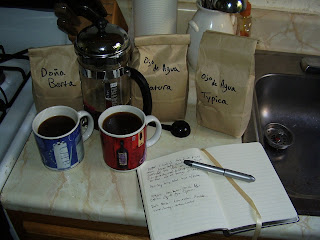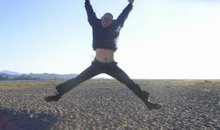I recently traveled to
Friday and Saturday: I landed in
Sunday: The next day I woke up to find cows right outside of my window. I hadn’t seen any of the land in daylight so I was blown away by the scenery. It was amazing! The Petersons have several dairies in addition to the coffee farms. One of the milking parlors was right across the road from my casita. I went into the house and Susan had brewed a pot of Esmeralda Geisha through a Technivorm. OMG it was incredible to drink coffee on the farm. Price had to leave early that morning for an SCAA meeting in
Monday: This was one of the most significant days on my trip. Susan took me to the Jaramillo farm to work and hang out with my new buddy and foreman of the Jaramillo farm, Poldo. Poldo and I hiked all over the farm. He showed me all of the different sections of the farm including Mario’s valley where the Best of Panama Geisha is grown. According to Poldo, very few outsiders had ever seen this valley in person. I was a lucky boy. It was gorgeous. The Geisha plants carpeted the whole valley with hundreds of native trees poking through. He also showed me another section of the farm that had Geisha and Catuai growing in the same section. He had me taste the difference between the two in cherry form. The difference was amazing! The Catuai left a sweet, round, refreshing aftertaste while the Geisha left a slight sting down the back of my mouth and throat. Later, we rode around on his tractor and ran errands for the farm before lunch. The tractor only sat one so I sat on the fender and held on for dear life. The tractor was Poldo’s car. We even drove down the highway on it. I had lunch at the nursery with all of the Ngobe kids. They workers lived in tiny cement shacks and the kids wore tattered clothing. They were dirty and had little supervision but they were happy and it was easy to tell that they were loved. They took care of each other. We had rice and half of a sardine for lunch. I was a guest so they chopped up a little cabbage for me. The kids loved my camera so I let them take a bunch of pictures. After a short after-lunch soccer game and photo shoot with the kids, it was time for me to do some cosechando (harvesting). I strapped on my bucket and went to work on a section of a field near the nursery. It was awful. It was important to pick only the ripe cherries and to twist them off to avoid injuring the plant. No stripping of the branch was allowed. So much work and care go into harvesting on Esmeralda. Since coffee cherries don’t all ripen at the same rate, the pickers have to circulate between different sections of the farm for months on end and keep picking the same trees. I picked 4.5 lbs. I only worked for a little bit and a couple of the kids from the soccer game came over and made fun of me so I didn’t pick a lot. I was busy beating up little Ngobe kids. Not really. I met back up with Poldo to pick up all of the coffee from the day at a couple of receiving stations (recibideros). Everyone else picked way more than I did. They laughed when we weighed my bag. After that, I helped load all of the bags into an old army truck to be taken to the
Tuesday: I got up early to drive to Volcan, on the other side of Volcan Baru, to visit Finca Hartmann. This journey should have taken 2 hours but took me 3 because I get lost in
Wednesday: I got up early and went down to one of the few coffee houses in Boquete, Café Ruiz. I was having a pretty good cappuccino when I looked into the back door of the warehouse and noticed that they were roasting coffee. I asked if I could have a tour. It was cool. They are one of the top producers in the area and I got to tour the facilities. I also got to meet Senor Plinio Ruiz, 86 years old, who still works and drives his car around. Between his broken English and my broken Spanish, we had a great conversation. I also met Maria and Plinio Jr, Plinio’s kids. It was great! They sell 10% of their coffee locally and the rest all over the world. Sr Ruiz wanted my opinion of his coffee. They asked me to cup coffee with them but I had an appointment to cup some more Geisha samples back at Esmeralda with Rachel and Abel. What an honor! I drove back out to Esmeralda where we cupped three Geishas and a Catuai. One of the Geishas needed two or three more months of reposo in the warehouse. It lacked the floral qualities that Geisha usually has but it had nice acidity. It was a little out of balance though. The others were getting pretty close. They were more round, had great acidity and great floral aromas. The Catuai was good but very obviously not Geisha. It was a very balanced cup with chocolate and nutty tones. I had the opportunity to practice cupping with numbers. I haven’t really had very much experience scoring coffees. I decided to stick to descriptors on the flavor wheel but I looked over and it was all in Spanish so I just slurped and nodded.
Thursday: Today Rachel took me up an insane road to Canas Verdes (green canes) in the Isuzu Patrol. This is the highest point on Esmeralda. Back in a remote canyon lays their highest grown Geisha. We hiked up to where we thought the Geisha was. I tasted a cherry off of a tree and said that it didn’t taste like Geisha cherries. Rachel called Daniel and he said that the Geisha was further down the hill. Poldo had taught me how to taste and tell the difference. Thanks Poldo! We found the Geisha section of Canas Verdes. There was little to no fruit on the trees. It will produce fruit in a year or two. We were at around 1800 meters above sea level. Coffee doesn’t really grow much higher than that, or so I thought. We went to dinner with the rest of the family and they invited me to the SCAP (Specialty Coffee Association of Panama) meeting/cupping the next day. I said “Yes, I would love to come to a meeting/cupping that may influence the entire coffee world with you tomorrow”.
Friday: I got up and went with Daniel and Rachel to the SCAP office in Boquete. They were discussing the idea of separating the varietals by table at the next Best of Panama Competition. Some were opposed and some were in favor. The reasoning behind it was that not all of the farms had submitted Geisha and Geisha had been kicking everything else’s ass every year. I think it is a bad idea. They either need to separate everything like processing method, varietal, elevation or nothing at all and keep it all on one table. They also thought that the contest should be in Boquete instead of Volcan since there were only one or two farms from Volcan submitting samples and many more from Boquete. I was supposed to meet up with Graciano Cruz (Ninety Plus developer and producer of Honey Bean,
Saturday: I woke up before Graciano, and made another pot of Geisha and sat on the porch with Gabriel, Graciano’s youngest son. I can’t even type the words to describe the incredible sense of appreciation I had for the setting I was in. We were just waking up to another sunny day on the porch in a coffee field, drinking Geisha. Later, we met up with Jose David Garrido of Garrido Coffee and Ninety Plus. Graciano had things to do so Jose David and I drove all over the place. He showed me many different farms including Mama Cata. He told the story of the naturally processed Geisha. Based on a dream, he decided to take an inventory of everything in his beneficio, including garbage. A day or two after that, Graciano Cruz and Joseph Brodsky (Ninety Plus and Novo Coffee Roasters) showed up and asked Jose David if he had any Geisha that was still in the cherry. He did and he knew it. They roasted and cupped it. It blew their minds. Jose David had more to show me but my stay in Boquete was over. I had to leave for David to fly back to
This was one of the most amazing times of my life. I thought I would learn mostly about the growing methods and science of coffee farming when I was there, but I feel like I learned a lot more about the people behind the coffee. I wanted to thank each and every cosechero (picker) for carrying those 150 lb bags of cherries up the mountains every day. I wanted to thank that driver who picks up all of the cherries 3 times a day to take them to the mill. I wanted to thank all of the mill workers and office workers. I wanted to thank of all the farmers and producers for taking such great care to make sure every detail is covered and that they make the best cup possible. Thank you Susan, Rachel, Daniel, Price, Poldo, Abel, Graciano and Jose David. I’ll be back to visit soon.







